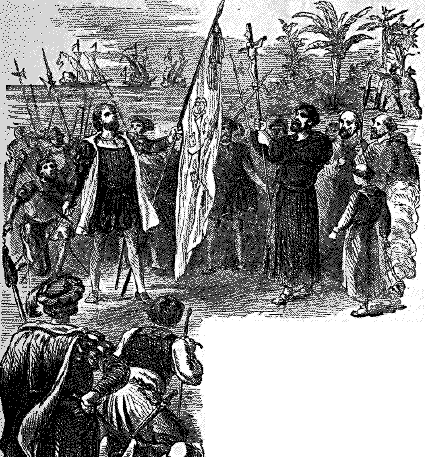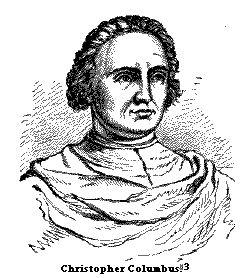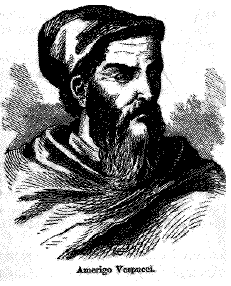Resource Center OLLibrary
|
6 |
|
ANALYSIS.
PERIOD I. -- DISCOVERIES.
Chap. I. -- Spanish Expeditions.
I. Columbus, p. 7.
II. Spaniards in the South, p. 11.
III. Spaniards in the United States, p. 12.Chap. II. -- French Expeditions.
I. Early Expeditions in the North, p. 14.
II. The Huguenots, p. 15.
III. Later Expeditions, p. 15.Chap. III. -- English Expeditions.
I. Discoveries and Explorations, p. 16.
II. Attempts to form Settlements, p. 16.
III. Charter of Virginia, p. 17.Chap. IV. -- Condition, at the Close of this Period, of what is now the United States.
I. Progress of Discovery, p. 18.
II. Claims, p. 20.
III. Aborigines, p. 21.Chronology, p. 26.
PERIOD I.
DISTINGUISHED FOR DISCOVERIES.
EXTENDING FROM THE DISCOVERY OF SAN SALVADOR BY
COLUMBUS, 1492,
TO THE FIRST PERMANENT ENGLISH SETTLEMENT, AT
JAMESTOWN, VIRGINIA, 1607.

Landing of Columbus.
SPANISH EXPEDITIONS.
I.
COLUMBUS.1--1. The honor
of the discovery of America2 belongs to Christopher
Columbus, as an individual, and to Spain, as a nation.
Columbus was born about the year
1435, in Genoa, a city of Italy. At the age of fourteen, after
having acquired some knowledge of geometry, geography, astronomy,
and navigation, he entered upon a seafaring life. About twenty
years later we find him in Lisbon, attracted, no doubt, by the
spirit of maritime enterprise, of which that city was then the
centre.
1 In Italian, Columbo; Latinized, it becomes Columbus, by which name he is best known. In Spanish, his name is written Christoval Colon. See p.10, note 1.
2 There is reason for believing that the Northmen, in the 10th century, found their way to
QUESTIONS. -- 1. To whom belongs the honor of discovering America? To what nation?
-- When and where was Columbus born? What is said of Columbus at the age of fourteen? Twenty years later? Why did he go to Lisbon?
|
8 |
|
 2.
The Portuguese were at that time seeking a passage to
India1 by doubling the Southern extremity of
Africa.2 To Columbus this subject was invested with the
deepest interest. He believed the earth to be round, and his
daring mind conceived the project of reaching India by sailing
west, across the Atlantic. As Asia was supposed to extend much
farther east than it does, he thought that this passage would be
shorter than that which the Portuguese were endeavoring to
find.
2.
The Portuguese were at that time seeking a passage to
India1 by doubling the Southern extremity of
Africa.2 To Columbus this subject was invested with the
deepest interest. He believed the earth to be round, and his
daring mind conceived the project of reaching India by sailing
west, across the Atlantic. As Asia was supposed to extend much
farther east than it does, he thought that this passage would be
shorter than that which the Portuguese were endeavoring to
find.
3. Having formed
his theory, he matured the plan of a voyage to test its truth. Too
poor to fit out an armament for so important an expedition, he
applied for aid, probably to his native city, perhaps to
Venice, certainly to Portugal; but without success. He then sent
his brother Bartholomew to England to ask assistance of Henry VII,
but Bartholomew was taken by pirates, and did not reach that
country for several years; meanwhile Columbus repaired to Spain to
lay his plans before Ferdinand and Isabella, then on the united
thrones of Castile and Arragon.4 Seven weary years did
he urge his project upon the attention of the Spanish sovereigns.
At length Isabella undertook the enterprise, and Columbus was
commissioned, by the king and queen, admiral and viceroy of all
the lands he should discover.
4. A fleet,
consisting of three small vessels, was soon ready for the voyage.
Two of them, named the Pinta and Niña, were
without deck in the centre, but built high at the prow and stern,
with forecastles and cabins for the accommodation of the crew. The
ship of Columbus, the Santa Maria, was decked, and of
larger dimensions. On board of this fleet were ninety mariners,
together with various private adventurers, -- in all, one hundred
and twenty persons.
Newfoundland, or Labrador, and even visited the shores of Rhode Island and Massachusetts. But their discoveries appear to have slept in forgetfullness until after Columbus had established the existence of a Western World.
1 Then a common name for all Southern and Eastern Asia.
2 This passage was finally accomplished by Da Gama in 1497.
3 After an original contemporary portrait.
4 Ferdinand, King of Arragon, married Isabella, heir to the throne of Castile and Leon, and thus the two kingdoms were united, in 1479. Navarre was conquered, and Spain formed into one monarchy, in 1512.
QUESTIONS. -- 2. What were the Portuguese then seeking? What project did Columbus conceive? Why did he think this passage would be shorter than that which the Portuguese were trying to find? 3. What did COLUMBUS next do? What applications for aid did he make, and with what success? What of his brother Bartholomew? Before whom did Columbus then lay his plans? Who at length undertook the enterprise? 4. Name the ships of the fleet. Describe them. How many mariners? How many persons in all?
|
|
9 |
5. At dawn, on Friday,
August 12,1 1492, Columbus set sail from Palos, in
Spain, to find a western passage to ![]() India.
At dawn, Friday, October 21,2 after a voyage of
ten weeks, he reached an island, called by the natives Guanahani,
but which he named San Salvador.3 This island is
one of the Bahamas, in the West Indian archipelago.
India.
At dawn, Friday, October 21,2 after a voyage of
ten weeks, he reached an island, called by the natives Guanahani,
but which he named San Salvador.3 This island is
one of the Bahamas, in the West Indian archipelago.
6. Leaving Palos, the little
squadron first touched at the Canaries, and thence entered upon a
voyage of discovery in the unexplored Atlantic. On losing
sight of land the crews despaired of ever again seeing their
homes. As they advanced their terrors increased. They observed
that the needle varied from the north. This phenomenon, now
familiar, filled the sailors with consternation, lest their only
guide over the trackless ocean should fail them. Rugged seamen
shed tears, and some broke into loud lamentations. At length they
became mutinous, and demanded that their leader should attempt to
return to Spain. Columbus did not waver for a moment. On the
evening of October 20, indications of land were so strong that he
ordered a vigilant watch from each vessel. About ten o'clock he
thought he beheld a light glimmering at a distance, and soon a gun
from the Pinta gave the joyful signal of land; whereupon they lay
to, waiting impatiently for the dawn.
7. Early in the morning,
Columbus, in a rich dress, holding the royal standard,
landed with his men. All knelt and kissed the ground. Then
rising, the admiral drew his sword, unfurled the royal banner, and
took formal possession of the island in the name of his patrons,
Ferdinand and Isabella. The crews now crowded around their leader.
Kneeling at his feet, they implored his pardon for having
distrusted him, and promised the blindest obedience for the
future.
8. The Spaniards were surprised to
find the natives unlike any race of people they had ever
seen. They were of a dusky copper-color, naked and beardless, with
long black hair floating on their shoulders, or bound in tresses
round their heads. They supposed the Spaniards to have descended
from the skies. The ships they looked upon as winged animals, with
eyes of lightning and voices of thunder.
9. Columbus soon after discovered other
islands of the same archipelago, among the rest Cuba and
Hayti.4 All these islands he supposed to be a
part of India; and, as he had reached them by sailing west, they
were called the West Indies. Their inhabitants were called
Indians -- a name afterwards extended to the natives of the
adjacent continent.
1 August 3, 0. S. 3 Called Cat Island on some maps. San Salvador signifies Holy Saviour.
2 October 12, 0. S. 4 Also called St. Domingo; by Columbus named Hispaniola (Little Spain).
QUESTIONS. -- 5. When did Columbus set sail? Whence? What island did he reach, and when? 6. Leaving Palos, where did the squadron touch? its course thence? What is said of the crews? of Columbus? What took place on the evening of October 20? 7. What the next morning? 8. Describe the natives. How did they regard the Spaniards? The ships? 9. What other discoveries did Columbus soon make? Whence the names West Indies and Indians?
|
10 |
|
About three months
after the discovery of San Salvador, the admiral set sail for
Spain, where he arrived after a tempestuous voyage. His return was
hailed with acclamations of joy, and he was received by his
sovereigns with the greatest distinction.
10. Columbus made three other
voyages to the New World. On his second, in 1493, he laid, on
the Island of Hayti, the foundations of Isabella, the first
European town in America. ![]()
On a third voyage, in 1498, be discovered the continent of
America, near the mouth of the River Orinoco; and, on a fourth, in
1502, the coast of Central America.
11. While on his third voyage
his enemies, who, since the success of his first
expedition, had been striving to undermine his influence in Spain,
induced the king to appoint in his place another governor, who
seized Columbus and sent him to Spain in irons. On his arrival the
general outburst of indignation at his treatment compelled
Ferdinand to set him at liberty, but he never recovered his
authority.
 His
death occurred at Valladolid on the 30th of May, 1506, not
long after he returned from his fourth voyage1 He died
in ignorance of the real grandeur of his discovery. It remained
for subsequent explorers to prove that instead of merely finding a
new way to the remote regions of the Old World, he had indeed
discovered a new continent.
His
death occurred at Valladolid on the 30th of May, 1506, not
long after he returned from his fourth voyage1 He died
in ignorance of the real grandeur of his discovery. It remained
for subsequent explorers to prove that instead of merely finding a
new way to the remote regions of the Old World, he had indeed
discovered a new continent.
12. Columbus was entitled to the honor of
giving his name ![]() to
the land he had discovered; but in 1499, Amerigo
Vespucci,2 a Florentine merchant, visited the
Western Continent,
to
the land he had discovered; but in 1499, Amerigo
Vespucci,2 a Florentine merchant, visited the
Western Continent,
1 His body was first deposited in the convent of St. Francisco, but afterwards removed to a monastery in Seville. Some years later it was taken to the New World he had discovered, and deposited in the Cathedral of St. Domingo. After resting here for more than two hundred and fifty years, his remains were, in 1745, again removed, and with great pomp conveyed to the Cathedral of Havana, where they now repose. Sometime after his death, the ungrateful Ferdinand rendered to his remains the tardy honor of erecting over them a monument, with the inscription, "To Castile and Leon Columbus gave a New World."
Nuevo mundo dio Colon."
2 In Latin, Americus Vespucius, by which name he is frequently called.
QUESTIONS. -- What is said of Columbus's return voyage? How was he received in Spain? 10. What is said of the other voyages of Columbus? Second? Third? Fourth? 11. On his third voyage what efforts did his enemies make, and with what result? Where and when did Columbus die? How did he regard his discovery? 12. To what was Columbus entitled?
|
|
|
|
|
|
© 1999, 2000, 2001 for NEGenWeb Project by Ted & Carole Miller